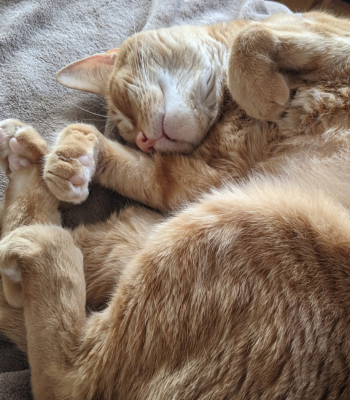Large Cell Lymphoma in Cats: Treatment options, palliative care, and how to know when it’s time for euthanasia
Large cell lymphoma is an aggressive cancer of the lymphatic system that affects cats. It progresses rapidly and, without treatment, can be fatal within weeks. Large cell lymphoma can affect the liver, kidneys, lymph nodes, intestines, and other organs. Unlike small cell lymphoma, which is slow-growing, large cell lymphoma progresses rapidly. Common symptoms include rapid weight loss, decreased appetite, vomiting, diarrhea, and lethargy. Even with treatment, most cats with large cell lymphoma do not survive more than about 6-9 months after diagnosis.
As a hospice and palliative care doctor, my goal is always: regardless of the path you choose, to make sure your cat’s remaining time left on this Earth is full of love and happiness. If your options are confusing, or you aren’t sure how to know when it’s time for euthanasia, don’t hesitate to schedule a comprehensive teleconsult with one of our doctors.
Treatment Options
There are three primary options: chemotherapy, steroids, and palliative care. The right choice is different for every pet and every family.
1. Chemotherapy for cats with large cell lymphoma
Chemotherapy can extend a cat’s life with large cell lymphoma. With chemotherapy, cats with large cell lymphoma on average 4-9 months, although there are some cats who do not respond at all, and some cats who can live more than a year.
Pros:
- Can extend survival time if patient response, sometimes achieving complete remission
- Some cats tolerate chemotherapy well with minimal side effects.
- In cats that respond partially, can improve quality of life by reducing tumor size and symptoms.
Cons:
- Can be expensive, with costs in the multiple thousands.
- Requires frequent vet visits for injections and monitoring.
- Some cats experience side effects such as nausea, lethargy, and decreased appetite.
- Long term remission and cure not usually achieved
Good Candidates:
- Younger, otherwise healthy cats with no major organ dysfunction.
- Cats that tolerate vet visits and handling well.
Poor Candidates:
- Cats with advanced disease and significant weight loss or weakness.
- Cats who experience severe stress at the vet.
2. Steroids (Prednisolone-Only Treatment) for large cell lymphoma
If chemotherapy is not an option, corticosteroids like prednisolone can sometimes slow progression of large cell lymphoma and relieve symptoms.
Pros:
- Can provide temporary relief by reducing inflammation and tumor size.
- Less expensive than chemotherapy and does not require frequent vet visits.
- Improves appetite and energy levels in many cats.
Cons:
- Survival time is much shorter than with chemotherapy (usually 1–3 months).
- Does not halt cancer progression—only provides temporary relief.
Good Candidates:
- Cats whose owners prefer a less intensive treatment approach but are able to give their cat an oral medication
- Cats who might be very stressed with repeated vet visits
Poor Candidates:
- Cats that cannot be medicated orally at home
- Cats who are already in severe distress and unlikely to respond
3. Palliative Care Only
For some cats with large cell lymphoma, chemotherapy or steroids may not be an option, either due to advanced disease, financial constraints, an inability to orally medicate a cat, or a desire to focus solely on comfort. In these cases, palliative care aims to keep the cat as comfortable and happy as possible.
Pros:
- Focuses on comfort and quality of life without the stress of treatment.
- Less costly and does not require frequent vet visits.
- Can allow cats to remain at home and stress-free.
Cons:
- Does not treat the underlying cancer, meaning progression is inevitable.
- Survival time is limited, often just weeks to a month or two.
Good Candidates:
- Cats with very advanced disease who would not benefit from treatment.
- Cats whose owners prioritize a peaceful, stress-free end-of-life experience.
Poor Candidates:
- Cats whose owners are wanting to pursue chemotherapy or steroids.
Palliative Care Recommendations
If you elect palliative care, or if your cat is no longer responding to chemotherapy or steroid treatment for large cell lymphoma, palliative care focuses on comfort and quality of life. Below are some treatments that may help your cat with large cell lymphoma feel better.
1. Pain Management
- Gabapentin or opioids (such as buprenorphine) can help relieve pain associated with tumors and inflammation as well as induce a sense of well being in your cat.
2. Appetite Stimulation and Nutritional Support
- Appetite stimulants like mirtazapine can encourage eating.
- Mirataz (a brand name of mirtazapine) can be rubbed on the ear which is helpful in cats that are difficult to medicate orally
- Offering palatable, high-calorie foods, including warmed wet food or prescription diets, may help maintain weight.
3. Anti-Nausea Medication
- Medications like maropitant (Cerenia) can prevent vomiting and nausea, which are common in advanced cases.
4. Fluid Therapy
- Subcutaneous fluids can help maintain hydration if the cat is not drinking enough and the process is not too stressful for them.
5. Fluid drainage
- Some cats will develop fluid in their bellies (peritoneal effusion) or around the lungs (pleural effusion). This fluid can sometimes be drained by your vet providing some temporary relief. The fluid comes back typically within days to a week. I don’t recommend doing this more than once or twice, as it can be quite a stressful procedure for your cat.
6. Environmental Comfort
- Provide soft bedding, easy access to food and water, and minimize stressors like loud noises or frequent disturbances.
7. Quality time and emotional support
- Focus on giving your cat love and support and cherish every moment left
- Monitor for signs of pain/discomfort and make decisions as needed
How to Know When It’s Time for Euthanasia
One of the hardest decisions you may have to face is deciding when it’s time for euthanasia. Because large cell lymphoma progresses quickly, it’s essential to think through some of these challenging decisions before you are in a crisis.
I highly recommend making a comprehensive end of life care plan for your cat as soon as they have been diagnosed with large cell lymphoma. Similar to an advanced directive in a human, you want to address important care questions like:
- Will you pursue chemotherapy with your cat with large cell lymphoma?
- If your cat needed to be hospitalized, would you do that?
- What are the objective set of criteria you will choose for when to elect euthanasia so your cat does not suffer needlessly
- Do you want to ensure your cat has a home euthanasia instead of passing away at a hospital?
- Is everyone in your family comfortable with this plan?
It is much easier to make these decisions when you are in a relatively calm frame of mind. When we are facing an immediate crisis of possibly losing our pets, it’s easy to make the wrong decisions in a panic. I’ve made this mistake myself.
I also recommend keeping a daily journal of your cat’s quality of life in a journal. I recommend simply putting a smile for a good day and a frown for a bad day. The journal can also be a place where you write new memories you made with your cat each day. It is important when facing the end of life to live in the moment and cherish every single day.
Our comprehensive quality of life scale (https://pawsatpeace.com/quality-of-life-scale/) can help you assess your cat’s quality of life. This quiz can be taken once to give you a snapshot of your cat’s quality of life, or taken multiple times to assess trends over time.
Finally, the most compassionate choice is to give your cat a peaceful goodbye before too much suffering has set in. If you do this, you can give your cat the gift of a peaceful last day, and they don’t need to know the severe suffering that often accompanies end-stage lymphoma.
When you are starting to see more bad days than good days, it’s a good time to give them a beautiful send-off. When clients wait too long, they often end up having to rush their beloved cat to the emergency room for euthanasia.
Signs That Euthanasia May Be the Kindest Option:
- Persistent loss of appetite, nausea, or vomiting: If appetite stimulants and nausea medications are no longer working, and your cat is not eating much for multiple days in a row, they may be experiencing significant suffering.
- Extreme weight loss and muscle wasting: A cat whose hip and spine bones are sticking out may be on the verge of multiple organ failure, leading to an emergency situation. I recommend considering euthanasia before this happens.
- Lack of interest in life: Most cats have a daily routine. Mine are active and playful in the morning and evening and take a long nap on my bed midday. One lies in the sun by the window in the afternoon. You know your own cat’s typical daily routines. If your cat is no longer doing the things they like to do, especially if they are isolating and hiding for much of the day, this is a sign they are suffering and it may be time for euthanasia.
- Difficulty breathing: If tumors are growing in the chest or fluid is accumulating around the lungs causing your cat to have labored breathing, I recommend euthanasia right away before it gets worse.
- Pain or distress: If your cat appears to be in pain or distress – crying out, hiding, or constant restlessness – that is not responding to, it may be time for euthanasia.
Conclusion
Large cell lymphoma is an aggressive and devastating diagnosis. I hope this guide has helped you make the best decisions for your cat diagnosed with large cell lymphoma. Whether pursuing chemotherapy, steroids, or palliative care, the most important goal is ensuring your cat remains as comfortable and happy as possible.
If you are not sure what to do and would like more guidance and support, we offer comprehensive teleconsults with compassionate veterinarians. We will review all your cat’s medical records and history, discuss all your options, and help you formulate the most compassionate and loving plan for your family.
And when it does come time, Paws at Peace offers in-home euthanasia to help your cat pass peacefully at home, surrounded by family. Home euthanasia can provide your cat with a gentle and dignified transition without the stress of a veterinary visit.

